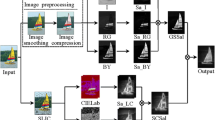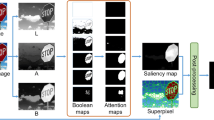Abstract
Image salient region detection is very useful in many multimedia applications, such as image retrieval, adaptive content delivery, and adaptive compression. Most existing methods are based on center-surround differences, usually detecting the differences around region boundaries, so these methods emphasize the high-contrast edges instead of detecting the regions. Different from traditional methods, our method smoothly propagates salient region information to the whole image by performing color interpolation and produces such saliency maps that uniformly highlight the whole salient regions and have high contrast between salient regions and backgrounds. We compare our method with five state-of-the-art salient region detection methods on a large public data set. The proposed method not only generates visually reasonable results but also achieves higher precision and better recall rates.
Similar content being viewed by others
References
Itti L, Baldi P. Bayesian surprise attracts human attention. Adv Neur Inform Proc Syst, 2006, 19: 547–554
Ma Y F, Zhang H J. Contrast-based image attention analysis by using fuzzy growing. In: Proceedings of the 8th ACM International Conference on Multimedia. New York: ACM, 2003. 374–381
Tsotsos J K, Culhane S M, Wai W Y K, et al. Modeling visual attention via selective tuning. Artif Intell, 1995, 78: 507–545
Setlur V, Takagi S, Raskar R, et al. Automatic image retargeting. In: Proceedings of the 4th International Conference on Mobile and Ubiquitous Multimedia. New York: ACM, 2005. 59–68
Christopoulos C, Skodras A, Koike A, et al. The JPEG2000 still image coding system: an overview. IEEE Trans Consum Electr, 2000, 46: 1103–1127
Ko B C, Nam J Y. Object-of-interest image segmentation based on human attention and semantic region clustering. J Opt Soc Am A, 2006, 23: 2462–2470
Han J, Ngan K, Li M, et al. Unsupervised extraction of visual attention objects in color images. IEEE Trans Circ Syst Vid, 2006, 16: 141–145
Fu Y, Cheng J, Li Z, et al. Saliency cuts: an automatic approach to object segmentation. In: International Conference on Pattern Recognition. Tampa: IEEE, 2008. 1–4
Niu Y Z, Liu F, Li X Q, et al. Image resizing via non-homogeneous warping. Multimed Tools Appl, 2012, 56: 485–508
Niu Y Z, Liu F, Li X Q, et al. Warp propagation for video resizing. In: IEEE Conference on Computer Vision and Pattern Recognition. San Francisco: IEEE, 2010. 537–544
Itti L, Koch C, Niebur E. A model of saliency-based visual attention for rapid scene analysis. IEEE Trans Pattern Anal, 1998, 20: 1254–1259
Achanta R, Estrada F, Wils P, et al. Salient region detection and segmentation. In: International Conference on Computer Vision Systems. Berlin: Springer-Verlag, 2008. 66–75
Harel J, Koch C, Perona P. Graph-based visual saliency. Adv Neur Inform Proc Syst, 2007, 19: 545–552
Hou X, Zhang L. Saliency detection: a spectral residual approach. In: IEEE Conference on Computer Vision and Pattern Recognition. Minneapolis: IEEE, 2007. 1–8
Gopalakrishnan V, Hu Y, Rajan D. Random walks on graphs to model saliency in images. In: IEEE Conference on Computer Vision and Pattern Recognition. Miami: IEEE, 2009. 1698–1705
Achanta R, Hemamiz S, Estraday F, et al. Frequency-tuned salient region detection. In: IEEE Conference on Computer Vision and Pattern Recognition. Miami: IEEE, 2009. 1597–1604
Levin A, Lischinski D, Weiss Y. Colorization using optimization. ACM Trans Graphic, 2004, 23: 689–694
Engel S, Zhang X, Wandel B. Colour tuning in human visual cortex measured with functional magnetic resonance imaging. Nature, 1997, 388: 68–71
Rother C, Kolmogorov V, Blake A. “GrabCut”: interactive foreground extraction using iterated graph cuts. ACM Trans Graphic, 2004, 23: 309–314
Author information
Authors and Affiliations
Corresponding author
Rights and permissions
About this article
Cite this article
Liu, Y., Li, X., Wang, L. et al. Interpolation-tuned salient region detection. Sci. China Inf. Sci. 57, 1–9 (2014). https://doi.org/10.1007/s11432-012-4730-4
Received:
Accepted:
Published:
Issue Date:
DOI: https://doi.org/10.1007/s11432-012-4730-4




